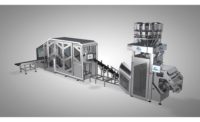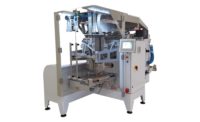When it comes to form/fill/seal (f/f/s) packaging systems, bakers and snack manufacturers are looking for increased bag-format flexibility, cleaner machine designs and easier maintenance. They want high speeds to maintain profitability and quick changeovers from one bag size to another without affecting product flow. Meeting the latest food-safety regulations is another key requirement. Manufacturers have upgraded their f/f/s systems to meet these needs.
Consumer influences
Consumer demand for convenience is also a driving force in machine requirements. It’s prompting food manufacturers to meet demand for small, single-serve packages, as well as packages with reclosable features, such as zippers or peelable seals. Consumers are asking for resealability and easy-opening features in a variety of package sizes, too.
“One trend is the increasing demand for quad-seal, stand-up bags,” says Kim Magon, marketing manager, Triangle Package Machinery Co., Chicago. “The appeal of this package structure seems to stretch across all markets, from cereal to crackers and snacks. In addition to better shelf visibility, the advantages of quad-seal, flat-bottom bags include improved material savings and sustainability, as these bags can eliminate the need for an outer carton.”
John Spears, national sales manager of HayssenSandiacre, Duncan, S.C., sees increased consumer demand for stand-up bags, quad-seal and Doyn-style packs. “Our customers want a stand-up package that will gain attention on store shelves and refrigerated displays,” he notes. The company’s vertical f/f/s machine, the Novus Doy/Quad, combines high speed and rapid changeovers to produce stand-up pouches. The
system can create the following package styles: Doy packs; quad packs; flat-bottom bags, tucked/gusseted bags and pillow bags.
Ross Long, vice president of Kliklok-Woodman, Decatur, Ga., agrees that there is a growing consumer demand for single-serve and portion control. Portable snacking occasions or mini meals on-the-go are driving this trend as consumers seek a wider variety of snack and meal options. In the production facility, this puts a premium on rapid changeover features along with higher speed capabilities.
“Consumer convenience is important, so we have introduced a multipack baler machine that automatically packages multiple single-serve bags into a space-efficient bale,” Long says. “The machine allows bakers and snack companies to capitalize on consumer demand for easy access to individual packs, while maintaining a high ‘ring’ value of larger package sizes.”
The health and wellness trend also has increased the demand for smaller bag sizes, according to Bob Fritz, business development director, tna Australia Pty Ltd., Sydney. As a result, he says, bakery and snack plants want f/f/s systems that deliver high speeds needed to maintain profitability, as well as an easy way to quickly change bag sizes.
Packed for performance
Among a host of recent equipment introductions throughout the industry, Bosch Packaging Technology, New Richmond, Wis., has introduced the SVC 4020, a vertical f/f/s machine that offers easy cleaning. The SVC 4020 gives bakers and snack manufacturers the versatility they need to package practically any free-flowing product and the ability to react quickly to changing end-user demands, according to Martin Dupick, global product manager. The vertical system accepts products ranging from dry powders like infant formula to nuts, confectionery products, mixed salads, cheese, protein and frozen food.
The SVC 4020 platform accommodates multiple bag styles, including pillow, side-gusseted, stand-up, corner-seal and Doyn-style, with various reclosing and easy-opening features, and bag sizes up to 400 mL. Bakers and snack manufacturers also can choose from a range of sealing technologies, including film heat-seal, conventional heat-seal and ultrasonic.
Triangle Package Machinery’s X-Series bagging machines integrate a zipper applicator into the film cage, which saves on floorspace. The company recently enhanced its zipper applicator with new features to improve accessibility and changeover time. “For example, we’ve relocated the Festo valve for easy access and maintenance and modified our zipper feed belt for easy changeover,” says Magon. Triangle also has introduced ultrasonic sealing.
HayssenSandiacre launched an integrated zipper applicator on its Novus vertical f/f/s system, resulting in a smaller footprint on the plant floor. The integrated zipper unit has a simple design and easy changeover, explains Spears. The company also has unveiled quad-pack flowrapping equipment, which is relatively new to horizontal flowrapping.
Tna recently introduced the tna robag 3ci, a vertical f/f/s machine that offers throughput rates of 250 bags per minute. The bagger is upgradable to any combination of jaw size or configuration (rotary single, double, triple or rotary flat jaw), which gives bakers and snack manufacturers full flexibility of bag size, type and application on a single system, says Fritz.
Kliklok-Woodman’s Apache CM bagmaker features a rotary sealing system that provides up to twice the available sealing time of competitive continuous-motion bagmakers at speeds of 160 bags per minute. “Because the seal system uses ‘flat-jaw,’ more bag formats are possible without complex changeover than are possible on twin-jaw systems,” Long explains.
Luis De la Mora, vice president of sales and marketing at Rovema Packaging Machines and Bossar USA, Lawrenceville, Ga., says Bossar has introduced the BMS series of full-servo-motor horizontal f/f/s machines, which produce different packaging styles, such as three-side-seal and four-side-seal pouches and stand-up pouches. A zipper and spout can be added to the units. “The new BMS series goes from a mechanically driven cam machine to a servo-driven unit where adjustments are easier and changeover times reduced, with the added benefit of increased efficiencies and speeds,” De la Mora says. “Also, the BMS can work with pre-made pouches.”
Haver Filling Systems Inc., Conyers, Ga., has introduced the ADAMS 12, which fills 33 bags per minute. The machine is equipped with 12 filling spouts that synchronize bag operations with a specified filling speed to provide continuous high-speed production. The unit confirms that bags are filled to a precise weight between 10 and 94 lb. It also has a vibrating unit that compacts the product for a tight fit. According to Haver, the ADAMS 12 ensures that bags are accurately and securely placed on filling spouts, which makes the bags easier to seal, while creating a dust-free work zone.
Reiser offers a system for applying film to the top and bottom of packages with full printed graphics that is easy to set up and has no impact on the speed of the machine, according to Patrick Ditchfield, vice president of Reiser, Canton, Mass. “It works with almost any kind of film, from very stretchy to semi-rigid. This allows for low-cost, ‘green,’ attractive package formats,” he notes.
Ditchfield also sees a growing interest in the use of modified atmosphere packaging (MAP) on horizontal thermoform/fill/seal (tf/f/s) machines. “This seems primarily related to consumers’ desire for specialty products such as gluten-free or products that are free of other allergens—products with large but distributed markets,” he says. “Five years ago, most bakeries calculated that the cost of MAP was too high compared to the benefits of extended shelf life. Now, with an opportunity to extend the distribution chain and distribute specialty products both nationwide and internationally, they see the cost of the packaging as relatively small compared to the benefit. This is a trend we have seen in other areas of food production for years.”
Safety regulations
Many bakers and snack producers are also requesting cleaner machine designs and easier maintenance, as they try to determine how to meet the Food Safety Modernization Act (FSMA) regulations. Equipment manufacturers are responding with “clean” designs.
To accommodate the various food-safety regulations on a global scale, and particularly U.S. hygienic standards, Bosch launched its SVC platform, which offers a wide range of hygienic features to meet customer requirements. Its dry cleaning configuration allows for basic wiping when packaging most dry foods and powders. For wet cleaning, the SVC can be wiped down with simple cleaning agents. “For situations that require more intense cleaning procedures with foam cleaning agents, the SVC is available in a washdown configuration,” says Dupick.
“Tna understands that food safety is paramount for any bakery and snack plant,” says Fritz. “Our traceability solutions, including our expert automation and controls capabilities, help these plants protect the consumer, as well as meet new FSMA regulations by providing full visibility of the production line. In addition, the enhanced sanitary design and simplicity of tna f/f/s equipment ensures easy cleaning to minimize downtime and reduce the risk of allergens entering the value chain.” SF&WB











